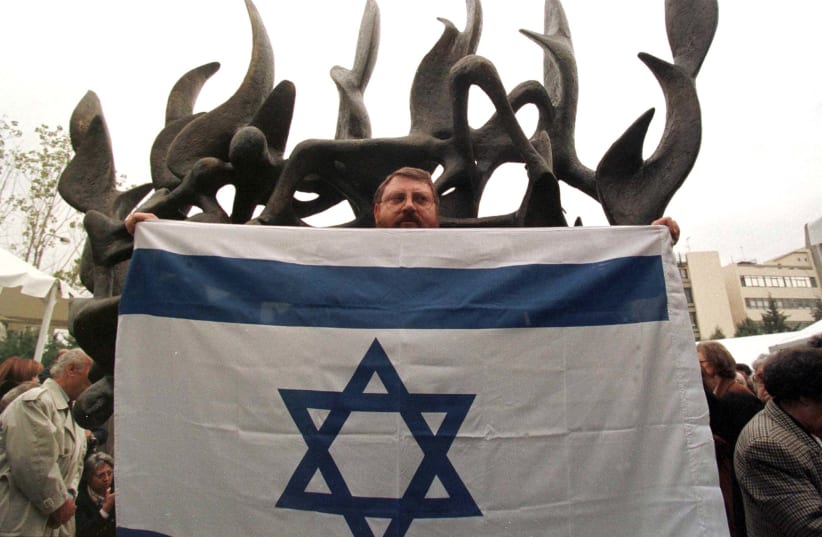When it comes to stories of the Holocaust, more often than not we think of the lost Jewish worlds of Vilna and Krakow and Prague. With her book Family Papers: A Sephardic Journey Through the Twentieth Century, Sarah Abrevaya Stein implores us to remember all that was lost in Salonica, modern-day Thessaloniki, Greece, which once boasted a thriving Sephardi community.
Salonica was “one of the few cities in modern Europe ever to claim a Jewish majority,” and 98% of that population was wiped out during the Holocaust, “one of the highest rates of annihilation to affect a single community.” The city was home to the largest Jewish cemetery in Europe before the gravestones were destroyed, many of which were used to pave city roads or construct an expansion of the Aristotle University of Thessaloniki.
Because the city’s role in Jewish heritage may often be overlooked by the average Ashkenazi reader, Stein provides a primer in Salonica’s history through the eyes and letters of a once-local Jewish family, the sprawling Levy clan.
Stein compares Sa’adi Besalel Ashkenazi a-Levi, a progenitor of the Levy family, to Sholem Aleichem’s Tevye. Both their children “walked down all the paths modernity offered for Jews.”
If Tevye’s six fictional daughters are caricatures of the possibilities that branched out before Russian Jews of the turn of the twentieth century, Sa’adi’s children walked the byways favored by modern Sephardic Jews. Sa’adi’s children go on to be teachers, political commentators and bureaucrats. They emigrate as well, but something sets Sa’adi’s family apart: “Not one of Sa’adi’s children married a non-Jew, as did Tevye’s Chava - yet the children gradually assimilated into various adopted milieus, such that their own children would grow up worlds apart even if still, for the most part, Jewish.”
At the end of the 19th century, Stein writes, “Salonica, like the [Ottoman] empire as a whole, was rapidly changing, to the roar of trains and the rustling of legal documents.” All of this comes to a screeching halt with the 1917 Salonica fire that destroyed “thirty-two synagogues… along with nine rabbinical libraries, six hundred Torah scrolls, and eight Jewish schools…. The damage was estimated at a billion French francs, 75 percent of which was Jewish-owned property.”
It’s almost as if the 1917 conflagration foreshadows the second destruction by fire which would strike the city’s Jewish population. The book’s most compelling writing occurs during the Holocaust years when entire branches of the Levy family tree were wiped out, from four-year-old Lenora Menasse to the 81-year-old patriarch Daout Effendi. By the book’s end, you grasp the enormity of what happened to the tribe: “Of the thirty-seven members of the Levy family deported from France and Greece by the German authorities… only one was known to have survived the war.”
The stories of some family members are more interesting than others, but they fall in a line like dominoes without any time for processing or a common thread to string them together in a compelling manner. For much of the book, the threads connecting the story’s players aren’t adequately sturdy, nor are their ties to the historical moments in which they find themselves. It seems like you keep reading the same sentence, as if the book were filled were a completed Mad-Libs: “_____ Levy traveled from _____ to _____ in _____ with _____ papers.”
The family tree in the book’s introduction is so convoluted and crowded it requires a magnifying glass for proper perusal. Brief mentions of various Levys who aren’t referred to again add to the confusion. Because Stein relies so heavily on photographs from the family’s archives, her writing at times seems to be paragraph after paragraph describing black and white photos in detail, which are often included for the readers to see for themselves anyway.
Spiteful letters between the warring Levy brothers Leon and Emmanuel are perhaps the most interesting correspondences. The financial struggles of a family simply aren’t compelling reading a century later, but these juicy communications are, and they allow the reader to truly get to know the characters who otherwise seem to just be transiting from one town to another.
Though the book is often a scramble of names, dates and places interspersed with black and white photos and quotes from letters, the story of Vital Hasson, the family’s black sheep, to put it mildly, is gripping.
Hasson was the great grandson of Sa’adi a-Levi. During the Holocaust he served as the head of the SS Civil Guard in Salonica. He was “said to carry a whip and wear an SS uniform. He was said to have raped and sexually humiliated hundreds of women… to have killed children in front of mothers and mothers in front of children. His own wife called him a sadist. Later, in trial, he laughed at his accusers.”
Though Hasson’s story, which ends with his execution by Greece as “the only Jew in Europe tried as a war criminal,” is chillingly fascinating, whether wading through 170 pages of Levy family history is worth it will be decided by the reader.
Stein is a professor of Jewish Studies at UCLA but there are times when it seems that she is writing from well outside the Jewish world. She writes that one of the Levys was “gassed in the crematorium” at Auschwitz. It should go without saying that Jews were gassed in gas chambers and then burned in crematoria, but apparently this slipped by the editor.
Stein understates the Shema prayer as “a declaration of faith” rather than the central verbal tenant of Judaism, and describes the kaddish simply as “a hymn of praise to God.” The book seems torn between an academic project and a family memoir that flounders in between.
FAMILY PAPERS: A SEPHARDIC JOURNEY THROUGH THE TWENTIETH CENTURY
By Sarah Abrevaya Stein
Picador
336 pages; $18
